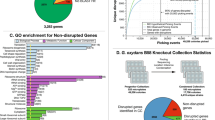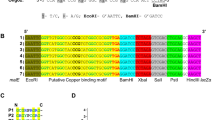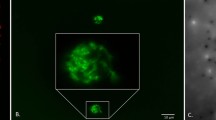Abstract
We have developed a radiation resistant bacterium for the treatment of mixed radioactive wastes containing ionic mercury. The high cost of remediating radioactive waste sites from nuclear weapons production has stimulated the development of bioremediation strategies using Deinococcus radiodurans , the most radiation resistant organism known. As a frequent constituent of these sites is the highly toxic ionic mercury (Hg) (II), we have generated several D. radiodurans strains expressing the cloned Hg (II) resistance gene (merA) from Escherichia coli strain BL308. We designed four different expression vectors for this purpose, and compared the relative advantages of each. The strains were shown to grow in the presence of both radiation and ionic mercury at concentrations well above those found in radioactive waste sites, and to effectively reduce Hg (II) to the less toxic volatile elemental mercury. We also demonstrated that different gene clusters could be used to engineer D. radiodurans for treatment of mixed radioactive wastes by developing a strain to detoxify both mercury and toluene. These expression systems could provide models to guide future D. radiodurans engineering efforts aimed at integrating several remediation functions into a single host.
This is a preview of subscription content, access via your institution
Access options
Subscribe to this journal
Receive 12 print issues and online access
$209.00 per year
only $17.42 per issue
Buy this article
- Purchase on Springer Link
- Instant access to full article PDF
Prices may be subject to local taxes which are calculated during checkout






Similar content being viewed by others
References
Riley, R.G., Zachara, J.M. & Wobber, F.J. Chemical contaminants on DOE lands and selection of contaminant mixtures for subsurface science research. US Dept. of Energy, Office of Energy Research, Subsurface Science Program, Washington, DC 20585 (1992).
McCullough, J., Hazen, T., Benson, S., Blaine-Metting, F. & Palmisano, A.C. Bioremediation of metals and radionuclides, US Dept. of Energy, Office of Biological and Environmental Research, Germantown, MD 20874 (1999).
Macilwain, C. Science seeks weapons clean-up role. Nature 383, 375–379 (1996).
http://www.em.doe.gov/bemr96. The 1996 Baseline Environmental Management Report.
Gorby, Y.A. & Lovley, D.R. Enzymatic uranium reduction. Environ. Sci. Technol. 26, 205–207 (1992).
Higham, D.P., Sadler, P.J. & Scawen, M.D. Cadmium-resistant Pseudomonas putida synthesizes novel cadmium proteins. Science 225, 205– 207 (1984).
Ji, G. & Silver, S. Regulation and expression of arsenic resistance operon from Staphylococcus aureus plasmid pI258. J. Bacteriol. 174, 3684–3694 (1992).
Lovely, D.R. Bioremediation of organic and metal contaminants with dissimilatory metal reduction. J. Ind. Microbiol. 14, 85– 93 (1995).
Nies, D.H. & Silver, S. Ion efflux systems involved in bacterial metal resistances. J. Ind. Microbiol. 14, 186–199 (1992).
Tsapin, A.I. et al. Purification and properties of a low-redox-potential tetraheme cytochrome c3 from Shewanella putrefaciens. J. Bacteriol. 178, 6386–6388 (1996).
Turner, J.S. & Robinson, N.J. Cyanobacterial metallothioneins: biochemistry and molecular genetics. J. Ind. Microbiol. 14, 119–125 (1995).
Voordouw, G. & Brenner, S. Cloning and sequencing of the gene encoding cytochrome c3 from Desulfovibrio vulgaris (Hildenborough). Eur. J. Biochem. 159, 347 –351 (1986).
Thornley, M.J. Radiation resistance among bacteria. J. Appl. Bacteriol. 26, 334–345 (1963).
Rugh, C.L., Senecoff, J.F., Meagher, R.B. & Merkle, S.A. Development of transgenic yellow poplar for mercury phytoremediation. Nat. Biotechnol. 16, 925–928 (1998).
Rugh C.L. et al. Mercuric ion reduction and resistance in transgenic Aribidopsis thaliana plants expressing a modified merAgene. Proc. Natl. Acad. Sci. USA 93, 3182–3187 (1996).
Brooks, B.W. et al. Red-pigmented micrococci: a basis for taxonomy. Int. J. Syst. Bacteriol. 30, 627–646 (1980).
Minton, K.W. Repair of ionizing-radiation damage in the radiation resistant bacterium Deinococcus radiodurans. Mutat. Res. DNA Repair 362, 1–7 (1996).
Daly, M.J., Ouyang, L. & Minton, K.W. In vivo damage and recA-dependent repair of plasmid and chromosomal DNA in the radioresistant bacterium Deinococcus radiodurans. J. Bacteriol. 176, 3508 –3517 (1994).
White, O. et al. Complete genome sequencing of the radioresistant bacterium Deinococcus radiodurans R1. Science 286, 1571– 1577 (1999).
Hansen, M.T. Multiplicity of genome equivalents in the radiation-resistant bacterium Micrococcus radiodurans. J. Bacteriol. 134, 71–75 (1978).
Lange, C.C., Wackett, L.P., Minton, K.W. & Daly, M.J. Engineering a recombinant Deinococcus radiodurans for organopollutant degradation in radioactive mixed waste environments. Nat. Biotechnol. 16, 929–933 ( 1998).
Summers A.O. Organization, expression, and evolution of genes for mercury resistance. Annu. Rev. Microbiol. 40, 607–634 (1986).
Schottel J.L. The mercuric and organomercurial detoxifying enzymes from a plasmid-bearing strain of Esherichia coli. J. Biol. Chem. 253 , 4341–4349 (1978).
Barrineau, P. et al. The structure of the mer operon. Basic Life Sci. 30, 707–718 ( 1985)
Daly, M.J., Ouyang, L. & Minton, K.W. Interplasmidic recombination following irradiation of the radioresistant bacterium Deinococcus radiodurans. J. Bacteriol. 176, 7506–7515 (1994).
Altschul, S.F. et al. Gapped BLAST and PSI-BLAST: a new generation of protein database search programs. Nucleic Acids Res. 25, 3389–3402 (1997).
Smith, M.D., Lennon, E., McNeil, L.B. & Minton, K.W. Duplication insertion of drug resistance determinants in the radioresistant bacterium Deinococcus radiodurans. J. Bacteriol. 170, 2126 –2135 (1988).
Daly, M.J. & Minton, K.W. An alternative pathway for recombination of chromosomal fragments precedes recA-dependent recombination in the radioresistant bacterium Deinococcus radiodurans. J. Bacteriol. 178, 4461–4471 (1996).
Daly, M.J. & Minton K.W. Interchromosomal recombination in the extremely radioresistant bacterium Deinococcus radiodurans. J. Bacteriol. 177, 5495–5505 (1995).
Fox, B. & Walsh, C.T. Mercuric reductase. Purification and characterization of a transposon-encoded flavoprotein containing an oxidation-reduction-active disulfide. J. Biol. Chem. 257, 2498– 2503 (1982).
Chang, J.S., Chao, Y.P., Law W.S. Repeated fed-batch operations for microbial detoxification of mercury using wild-type and recombinant mercury-resistant bacteria. J. Biotechnol. 64, 219–230 ( 1998).
Kobal, V.M., Gibson, D.T., Davis, R.E. & Garza, A. X-ray determination of the absolute stereochemistry of the initial oxidation product formed from toluene by Pseudomonas putida 39-D. J. Am. Chem. Soc. 95, 4420–4421 (1973).
Nakamura, K. & Nakahara, H. Simplified X-ray film method for detection of bacterial volatilization of mercury chloride by Escherichia coli. Appl. Environ. Microbiol. 54, 2871–2873 (1988).
Gibson, D.T., Cardini, G.E., Maseles, F.C. & Kallio, R.E., Incorporation of oxygen-18 into benzene by Pseudomonas putida. Biochemistry 9, 1631–1635 ( 1970).
Acknowledgements
This research was largely funded by grant DE-FG02-97ER62492 from the Natural and Accelerated Bioremediation Research program, Office of Biological and Environmental Research, DOE. Some of this work was also supported by the grant DE-FG07-97ER20293 and DE-FG02-98ER62583 from the DOE; and grant MDA-905-97-Z-0053 from the U.S. Department of Defense.
Author information
Authors and Affiliations
Corresponding author
Rights and permissions
About this article
Cite this article
Brim, H., McFarlan, S., Fredrickson, J. et al. Engineering Deinococcus radiodurans for metal remediation in radioactive mixed waste environments. Nat Biotechnol 18, 85–90 (2000). https://doi.org/10.1038/71986
Received:
Accepted:
Issue Date:
DOI: https://doi.org/10.1038/71986
This article is cited by
-
Microbial bioremediation as a tool for the removal of heavy metals
Bulletin of the National Research Centre (2023)
-
Acidophilic microorganisms in remediation of contaminants present in extremely acidic conditions
Bioprocess and Biosystems Engineering (2023)



